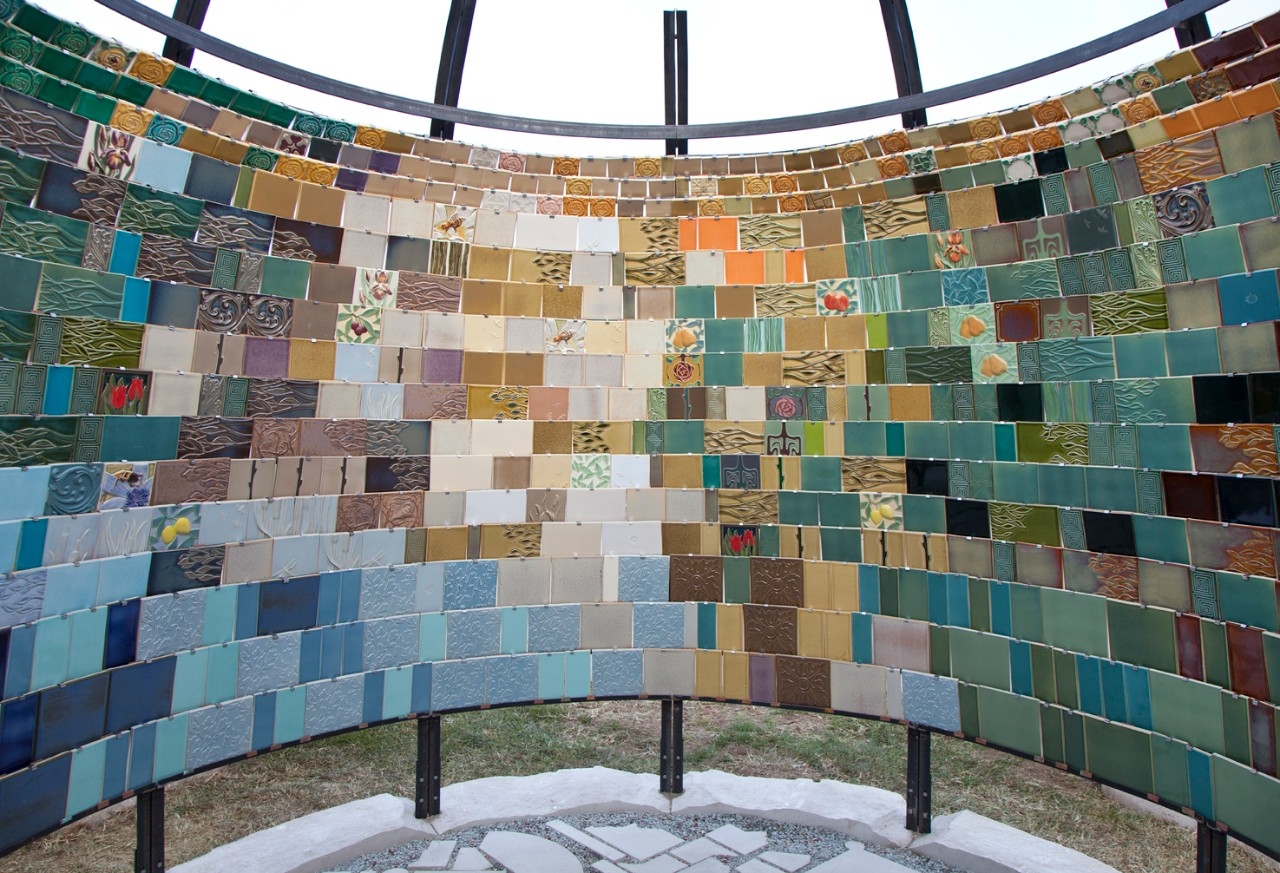Salvaged Rookwood tiles, laid in a pattern that transitions from cool to warm, form the "bejeweled" interior of an architectural installation, titled "Alchemy," created by University of Cincinnati students. The work will soon be on display in a garden spot near Italy's famed Venice Architectural Biennale, visited by more than 500,000 during its nearly six-month run. photo by Hadley Fruits
Cincinnati to Venice
An award-winning UC installation will soon go on display in Venice, Italy, in an exhibition coinciding with what is arguably the world’s most important architectural event, the Venice Architecture Biennale.
By M.B. Reilly
513-556-1824
Photos: Provided
May 9, 2018
Location. Location. Location.
When it comes to architecture, the city of Venice, Italy, has leverage that is unequaled anywhere else.
It’s not because of the city’s storied canals and architectural history that encompasses a wide range of influences from Byzantine to Baroque — but rather because the Floating City plays host every two years to what is known as the Venice Architecture Biennale. It’s an exhibition of architecture that draws highly respected practitioners — sometimes known as “starchitects” — along with the world’s art and design lovers who simply enjoy the critical mass of design sophistication, education and entertainment all gathered in one place.
And this year, a group of 14 University of Cincinnati students led by Terry Boling, associate professor of architecture in the College of Design, Architecture, Art, and Planning (DAAP), will be in Venice ahead of the May 26-Nov. 11 run of the 16th International Architecture Exhibition (titled FREESPACE) to install their own work in Venice’s Giardino della Marinaressa, a garden spot located along the city’s monumental waterfront. While the Cincinnati work (titled "Alchemy") is not among those of the official Biennale, the exhibition of this UC work in this overall context provides the students an opportunity to publicly display their work to an international audience that will number 500,000 or more during the run of events there.
“Alchemy reflects not only our university but also the city and region. It has a strong ‘Cincinnati ethic’ representing how we teach architecture here but also how we as a school and region bring unlikely elements together to create something beautiful,” said Boling of the work that has already earned a Cincinnati Design Award and was previously exhibited by invitation at the 2017 Architecture Biennial in Columbus, Indiana.
Just as the term alchemy signifies the medieval process of transmuting base matters into gold, UC’s “Alchemy” was first conceived as a student-centered Spring 2017 studio project and process to provide undergraduate and graduate students the chance to transform industrial scraps, left-overs, waste or rejected materials into an integrated whole. The experiential-learning project provided students the opportunity to manually construct an installation and to integrate community-based partnerships into the effort.

Rear view of the tiles used in the installation. Each tile, individually cast and glazed by hand, carries identifying Rookwood Pottery marks on the back.
“This project is like how your mom used to make soup from whatever was in the refrigerator. Take the left-overs and combine them into something new and delicious.”
‒ Terry Boling, associate professor at UC's College of Design, Architecture, Art, and Planning
“For me, the project was about things we are overlooking in our fast, technology-driven world. It's about incredible care - the care we take in first designing and constructing this installation, deconstructing it. Labeling and identifying every joist and finally re-assembling it in Venice. It's about a grounded education," said Robert Probst, DAAP dean, who initiated this interdisciplinary endeavor and served as the driving force behind broadening the project's reach in partnership with faculty members Boling; Joe Girandola, associate professor of fine art; and Matt Wizinsky, assistant professor of design. Providing mentorship were Danilo Palazzo, director, School of Planning, and Chris Auffrey, associate professor of planning.
Graduate student Andrew Campbell, 27, of Centerville, Ohio, who worked on the project as part of a Spring 2018 studio in preparation for its international debut, agreed, "There's something important and innately human about toiling away at something with your hands instead of at a computer. It's a different kind of work. It teaches you a different kind of persistence and a different kind of patience entirely."
Watch a 7-second time-lapse video depicting the laying of the floor. The floor depicts an outline of Cincinnati's 52 neighborhoods.
A 2:57 behind-the-scenes look at how UC architecture students created "Alchemy," soon to be on display in Venice, Italy.
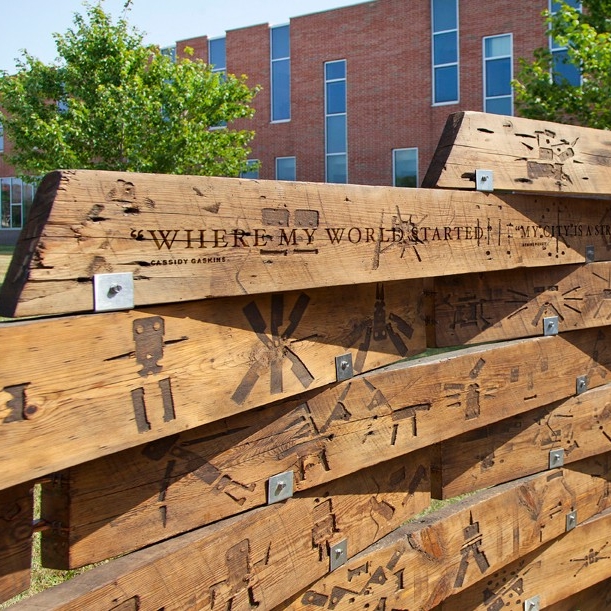
The woven wood wall displays geometric patterns designed and imprinted by middle school students. Area high school students contributed original poetry written about Cincinnati to the project. Portions of that poetry are also displayed on the wall.

The original floor of the installation was made of scraps of Indiana limestone. photo by Hadley Fruits
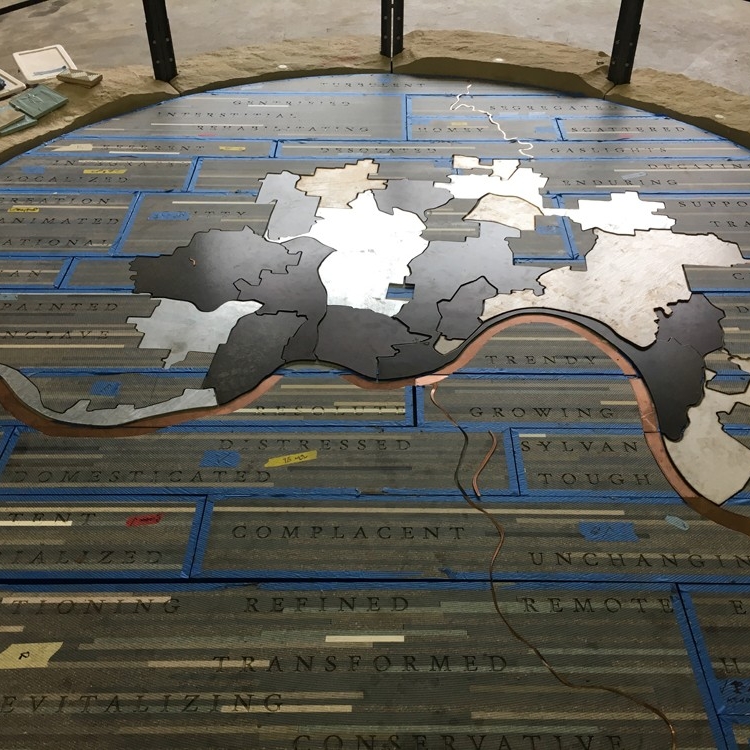
In Venice, a newly created floor will display an outline of Cincinnati's 52 neighborhoods as well as one-word descriptions of the city provided by members of the public.
The project makes use of forgotten and discarded materials such as reclaimed wood from a 150 year-old Cincinnati church, copper scraps, hundreds of handmade tiles rejected by a local tile manufacturer, fragments of decorative limestone from an Indiana stone quarry and more.
School children in Columbus, Indiana, helped transform the project’s century-old wood by imprinting it with geometric patterns by using pieces of copper — doing so thanks to a custom-made press crafted by the UC students. Moreover, poetry about living in Cincinnati is laser etched in this same wood — poetry written by local high-school students who have participated in “Louder Than A Bomb,” an annual poetry, spoken word, hip-hop competition.
The end result, according to graduate student Bailey Stultz, 25, of Columbus, Indiana, is "focused on the combination of materials to make up two very distinct curved walls: one made of wood and the other made of tile." At the center is a sheltered and sheltering space where all the elements serve to guide attention to and frame a bejeweled tile room.
“As a deliberately designed human-scale space, that little tile room, it just feels good when you’re in it,” said Probst.
Graduate student Campbell added, "I would hope people who experience the project feel a sense of age, workmanship and treatment of the materials as well as a general inquisitiveness towards Cincinnati. After all, at it's most essential, this project is about locality and cooperation, between people and materials here in Cincinnati."
Explained Boling, “This project is like how your mom used to make soup from whatever was in the refrigerator. Take the left-overs and combine them into something new and delicious. I think it also reflects both our Cincinnati heritage and our sustainable, urban futures. After all, we’re the city where a commercial empire (consumer products giant P&G) was originally built from turning 18th-century waste pig fat into candles and soap. Our future will, by necessity, reflect that heritage and the need to creatively reuse what we have to hand.”
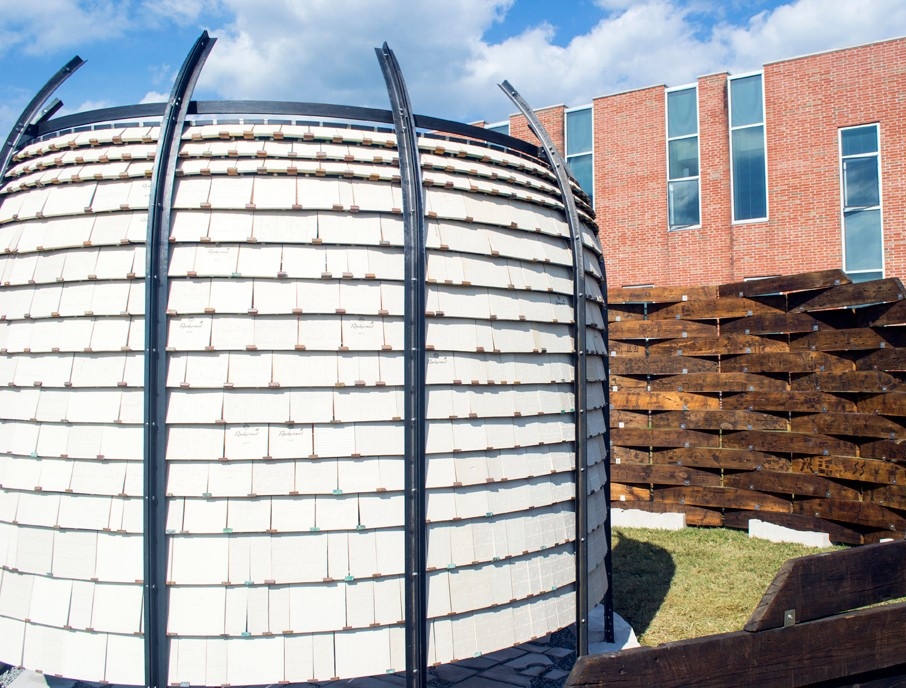
'Alchemy' reflects Cincy
The project makes use of waste materials from Rookwood Pottery Company and Formica Corporation as well as product from The Gorilla Glue Company. And community members have contributed.
Indiana limestone is used to fashion a map of Cincinnati’s 52 neighborhoods on the installation’s floor along with one-word descriptions of those neighborhoods, provided by local residents.
Taking its place on that map is UC's logo, marking the location of the Uptown campus. That logo will serve as one of nine trigger points integrated into the installation. At these trigger points, installation visitors will be able to view video of Cincinnati neighborhoods, iconic locales and city scenes via an app loaded to their cell phones or iPads.

This sign, designed by Joe Girandola, associate professor of fine art, will light the locale of the "Alchemy" installation.
All told, 25 UC undergraduate and graduate students worked on “Alchemy:”
Joshua Antolovic • John Arnaud • Shaun Baranyi • Cambrie Barowski • Alan Bossman • Caroline Bozzi • Justin Brown • Andrew Campbell • Daniel Castelle • Jessica Dangelo • Logan Halterman • JinHui Huang • Matthew Klump • Caleb Lang • Lexy Martone • Kristopher Miller • Matt Miller • Paul Neidhard • Brent Nichols • Ben Romero • Sanjay Sridhar • Bailey Stultz • Lauren Whitehurst • Charles Wiederhold • Russell Zimmerman
A student-centered curricular project, "Alchemy" embodies the university's Next Lives Here strategic direction by pointing the way to a sustainable urban future and providing opportunities for experiential learning and participation by community partners -- all topped off by international exposure.
UC Installation Set Within a Larger Context
In Venice, the UC installation will be set within a larger “TIME SPACE EXISTENCE” exhibition in multiple locales curated by the Global Art Affairs Foundation and the European Cultural Centre. These multiple exhibit spaces include works by professional architects, photographers, sculptors and universities.
For instance, UC’s “Alchemy” installation will be exhibited in its garden space, which will also contain a large-scale sculptural work by architect Daniel Libeskind. Yet another exhibition site will display work by architects Richard Meier and Curtis Fentress along with a project from North Carolina State University. Other schools represented in this year’s “TIME SPACE EXISTENCE” exhibitions include the University of Buffalo, University of Oklahoma, and international schools such as the Delft University of Technology in the Netherlands, Monash University in Australia, and Victoria University in New Zealand. However, UC is the only school exhibiting work that includes contributions by undergraduate students.
- UC’s Edson Cabalfin, associate professor of interior design in the DAAP School of Architecture and Interior Design, will serve as curator of the Philippine Pavilion at the official 2018 Venice Architectural Biennale.
- Faculty from diverse institutions will participate in the “Data and Matter” exhibit also curated by the GAA Foundation and European Cultural Centre at the Palazzo Bembo. Among the participating faculty are Mara Marcu, UC assistant professor of architecture, and Ming Tang, UC associate professor of architecture, as well as UC student Adam Schueler, along with faculty from institutions like City College of New York, Rensselaer Polytechnic Institute, and New York Institute of Technology.
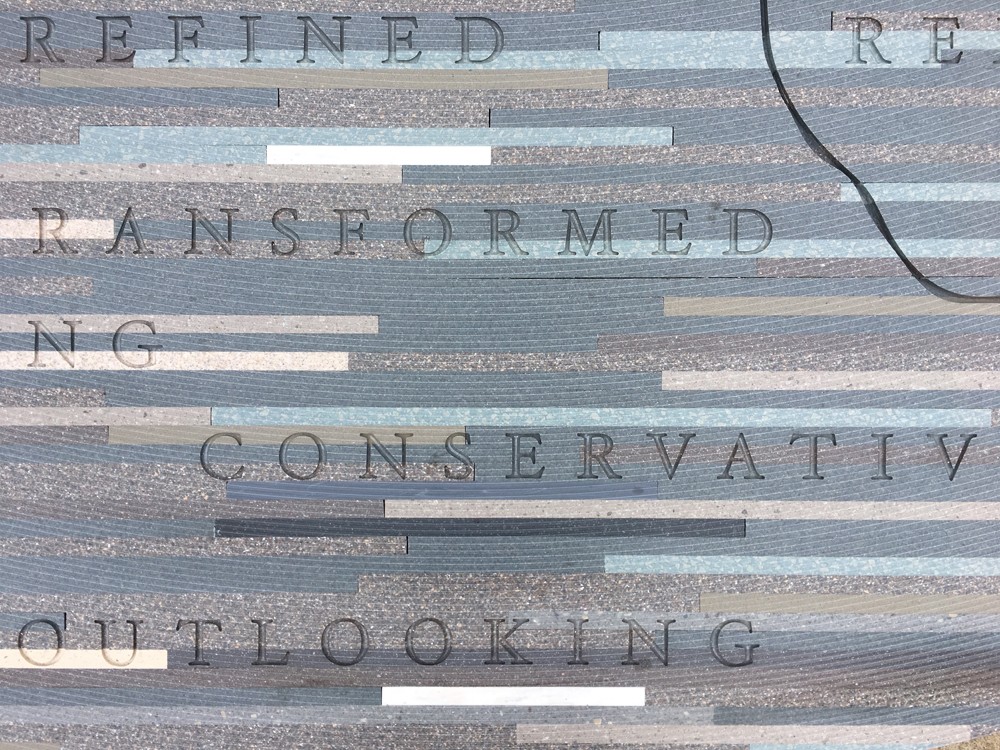
A detail from the floor of UC's "Alchemy" installation depicts words used to describe Cincinnati's neighborhoods, as provided by members of the public.
The Orville Simpson Fund at the University of Cincinnati
The “Alchemy” project is supported by the Orville Simpson Fund at DAAP. In 2011, the University of Cincinnati received a substantial gift from Orville Simpson, a Cincinnati real estate investor and entrepreneur with a futuristic outlook for architecture, design and urban planning. Simpson spent his adult life thinking about the problems of urban sprawl, overcrowding, crime and pollution. During this time — with no formal architectural, planning, or artistic training — Simpson dedicated his life to designing and documenting his solution to these problems: Victory City, “the City of the Future.” Some of the concepts he envisioned are now accepted as good practice or even cutting edge, e.g., farm-to-table meals with no additives and preservatives, and efficient land use.
Partnership with UC Press
University of Cincinnati Press is also partnering with DAAP and will be featured in wall panels that accompany the “Alchemy” installation. This DAAP-UC Press partnership will focus on a number of Urban Futures initiatives, including a book series edited by Edward Mitchell, director of the School of Architecture and Interior Design, and Danilo Palazzo, director of the School of Planning, and other publications that will document and build upon Simpson Center archives and programs.
Launched in 2017 with a focus on publishing scholarship which focuses on global social justice and community engagement theories, practice, research and solutions. UC Press is cultivating accessible and transdisciplinary books by scholars and practitioners including architects, planners, designers, engineers, educators, activists, health practitioners and community stakeholders bringing new modes of scholarship that can help sustain and reinvent the vitality of urban spaces. As a unit of UC Libraries, UC Press offers cutting-edge tech to create new interactive lenses on the written word. Besides digital projects, UC Press’ Cincinnati Library Publishing Services (CLiPS) is developing new affordable and open textbooks, conference proceedings and journals. Its inaugural list includes books on a wide array of social justice and community-engagement topics from city benefits agreements to postcolonial Indian architecture and design-build urban studio profiles as well as the journal, "Issues in Race & Society" (Association of Black Sociologists). Among its first transdisciplinary publications is a book series on community-engaged public health research, edited by UC’s Farrah Jacquez, associate professor of psychology, and Lina Svedin of University of Utah, identifying best practices in health leadership with integrated approaches to housing/health/mental health that provide stronger foundations for new jobs and community development opportunities to revitalize neighborhoods.
About the GAA Foundation
The GAA Foundation was founded in 2002 in New York, opened its Italian branch in 2011 and started the Venice-based activities in the same year. Since 2014, The GAA Foundation has partnered with the European Cultural Centre in the field of culture and education. From 2011-2016, the GAA Foundation served as an official, accredited, collateral part of the Venice Architecture Biennale. Starting in 2017 and this year, the Foundation made the choice to run during the same time period but independent of the Venice Architecture Biennale in order to fulfill its purpose of making the arts and architecture as open and available to all as possible. This non-commercial approach provides a welcome alternative to the ticketed, commercial events of the official Biennale/collateral events. As such, the GAA Foundation promotes an equitable and inclusive approach to making the arts available to all.
Bearcats Abroad
As part of their studies, experiential learning and co-op opportunities, UC students travel to 56 countries each year.
The UC student team at the 2017 Architecture Biennial in Columbus, Indiana. At far right is Associate Professor of Architecture Terry Boling.
Become a Bearcat
In the DesignIntelligence survey of the nation’s employers who hire design grads, UC’s graduate-level architecture program has ranked in the nation’s top 20 for more than a decade. Apply to UC’s undergraduate program in architecture or the graduate programs.

